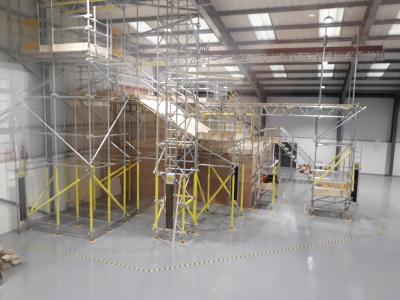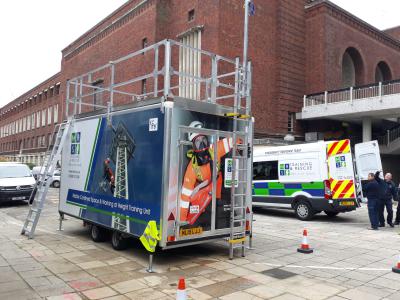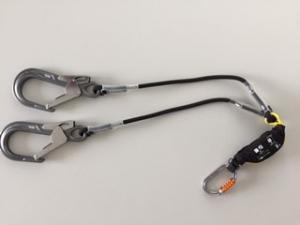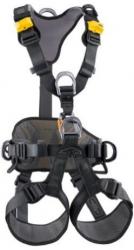Working at height is still the largest contributor to major injuries and fatalities to workers in the UK – across all industries.
What is working at height?
According to the ‘Work at Height Regulations 2005’ - working at height is any work which takes place where there is a risk of a fall which could cause an injury. Work at height doesn’t necessarily apply to tall buildings or roof – working at height is any type of work where a fall could happen. This includes:
- Working in a manhole
- At the top of a tank or pit
- On steep ground
- At the top of large open spaces – such as a ship tanker
How should I prepare to work at height?
The regulations in the UK state that those working at height should make sure they have followed the next steps before they attempt any work:
- Avoid: can work be done without having to work at height?
- Risk assess: what hazards are there?
- Control measures: what needs to be done, to keep workers safe?
- A safe system of work: has the right paperwork be provided – such as risk assessments?
- Emergency arrangements: can worker/s be rescued if something goes wrong?
All work at height should be properly planned and organised. It’s also important that those who attempt to work at height have the right training, experience and equipment. As with any type of dangerous work – the more time taken to consider risks and how they can be avoided, the more likely you are to work safely.
What are common work at height situations?
As mentioned previously, working at height is not always working on a roof or a tall building. Many people work at height every day but may not consider what they do something related to heights or the potential of falls.
Common working at height situations include:
- Working on scaffolding or mobile elevated work platforms (MEWPs)
- Working or climbing permanent structures – such as towers, tanks or wind turbines
- Working on excavations sites – such as underground chambers or cellar openings
- Working on fragile materials at height – such as on old roofs
- Working on top of a high vehicle – such as a truck
- Working on trees – or other natural materials at height
Other more unusual working at height situations include:
- Working at the top of a well
- Working on tunnels
- Working below ground level – in walkways
What training should I complete if I do work at height?
If you work at height – it’s important you have the right training. Check your industry bodies and guidelines, to see if they recommend or accredit courses particularly suited to your line of work.
For example, here at MRS Training & Rescue, our working at heights courses are accredited by industry bodies such as the Global Wind Organisation (GWO), ECITB and PASMA. Delegates who choose to complete a course accredited by these bodies will receive certification which is recognised by their industry and those bodies.
In addition to accredited courses, we also offer MRS Training & Rescue certification for courses we have developed ourselves – all of which meet the Working at Height Regulations 2005.
These courses include:
- Rooftop safety
- Advanced working and rescue from height
- Management of working at height
- Safety harness training
Are there specialist courses for specific industries?
Yes – here at MRS Training & Rescue we provide certified courses for those who are required to work on wind turbines. All of these courses are GWO accredited and provide basic safety training as a standard.
- Hub, Blade, Nacelle and Roof Rescue
- Safe Lifting and Slinging for Turbines
- Wind Turbine Basement Rescue
How will I learn to work at height safely?
At our training centres across the UK, we have indoor and outdoor height training facilities – so our delegates can learn the skills which will keep them safe, practically. With our courses, you can rest assure that you will not just be placed in front of a presentation. Instead, you will be taught by experienced trainers and rescuers – using quality equipment, in facilities which are actually ‘at height’.

In addition to our training centre facilities – we also have a mobile training unit, which allows us to deliver our courses anywhere! We can travel with our unit to your site to deliver training to your team, so you don’t have to lose time or pay for travel.

How often should I complete working at height training?
The exact timing of when you need to renew training certification will depend on the awarding body of your last training course. We always recommend that rescue teams complete regular in-house training to maintain a high-level of competency and efficiency.
What are the common misconceptions of working at height?
- Ladders and stepladders are banned
- Ladders and stepladders are not banned under health and safety law. In fact, they can be sensible and practical options for low-risk, short duration tasks.
- You cannot maintain 3 points of contact when completing work on a stepladder
- You should maintain threes points of contact when on a stepladder; your two feet and one hand. But, if you need to use both hands for a brief period and feel you are supported – two points of contact are acceptable.
- Work on a staircase is ‘working at height’
- Working at height does not include walking up or down permanantent staircases in a building.
- You are only ‘working at height’ above ground level
- Working at height can take place above or below ground – and in any place a person could be injured if they fell from that place. Access and egress to a place of work can also be classed as ‘working at height’.
- Harnesses can be adjusted to fit all sizes
- It is essential that harnesses are fitted correctly, and are in the right size. If harnesses are in the wrong size – attachement points may be in the wrong place and webbing straps can be loose – both of which could cause fatal injuries in a fall.
What do I need to do in a working from height emergency?
It is important that there is a suitable and sufficient emergency plan in place for working at height tasks – reliance on the emergency services is not enough. Every employer must risk assess all working at height tasks to develop a safe system of work, which includes a plan in place should the safe system of work fail.
When planning for an emergency – you should consider:
- How the alarm would be raised in an emergency?
- If there are suitably trained personnel available to carry out a rescue from height?
- Is there suitable emergency equipment readily available?
 What are common working at height PPE?
What are common working at height PPE?
A common type PPE for height is a fall arrest lanyard which connects the person working at height to an anchorage point. The lanyard is designed to prevent a fall by catching a person – and helps to prevent injury, by absorbing the forces of a person falling, to ensure they are never above 6Kn.
Another type of PPE used for work at heights is a full body harness. A full body harness protects workers from falls by distributing the force of a fall over a large area of the body to ensure a person remains in an upright position after a fall has occurred.
 A work positioning harness or a ‘site harness’ is also sometimes used. A site harness can be used as part of a rope access system or where there is a low point of attachment. This type of harness allows supports the whole body and the legs whilst working at height.
A work positioning harness or a ‘site harness’ is also sometimes used. A site harness can be used as part of a rope access system or where there is a low point of attachment. This type of harness allows supports the whole body and the legs whilst working at height.
Work restraint lanyards and fall arrestors. Both feature a restraint system which prevents a person being able to reach a fall. A fall arrestory also often features a two way winding handle which can be use during a rescue.




